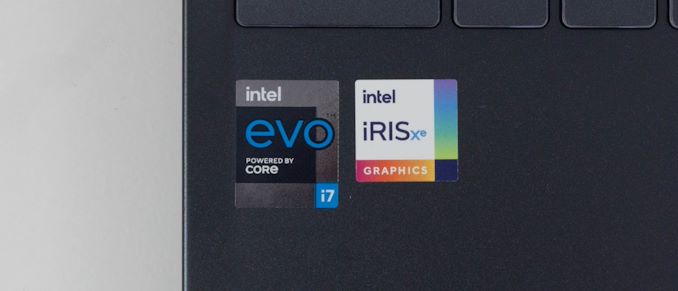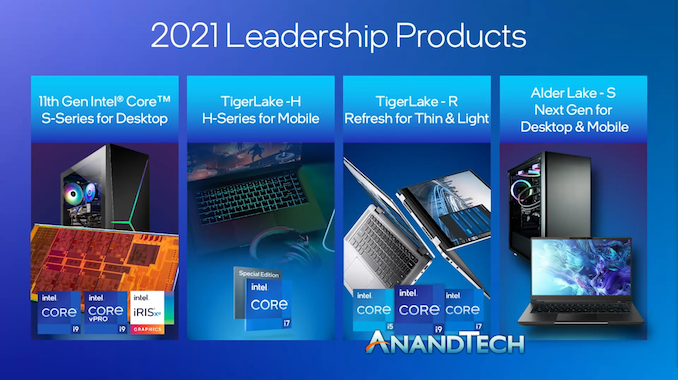Intel Confirms Tiger Lake-U Refresh Later in 2021
by Dr. Ian Cutress on April 27, 2021 10:00 AM EST- Posted in
- CPUs
- Intel
- Notebooks
- Tiger Lake
- Xe-LP
- Willow Cove
- 11th Gen
- Tiger Lake-U

The combination of Intel’s ability to drive 10nm product onto the shelves coupled with silicon supply chain shortages has put into question exactly what might be coming into the market later this year on the client side of the business. A few weeks ago Intel stated that across the company five CPU platforms would be coming to market in 2021: Rocket Lake, Jasper Lake, Ice Lake Xeon, Alder Lake, and the Tiger Lake-H series of processors. Tiger Lake-H at 45W+ will come to market in Q2, however AnandTech has learned and confirmed that later in 2021 Intel will also be launching a refresh of its notebook 15-28W Tiger Lake-U processors as well, called TGL-R.
The original Tiger Lake-U family was launched in September 2020 using Intel’s 10nm SuperFin manufacturing process. The silicon design used four of Intel’s latest Willow Cove processor cores, with the top 28 W model offering a turbo frequency up to 4.8 GHz and a base frequency of 3.0 GHz. Tiger Lake also enables 96 execution units of the new Xe-LP graphics technology, up to 1350 MHz, with support for DDR4-3200 and LPDDR4X-4266.
Technically Intel stated that Tiger Lake-U also supported LPDDR5-5400 when the product was launched, however we have not seen a Tiger Lake-U design with this feature. A Tiger Lake-Refresh might have this key feature enabled with a new family of processors, alongside minor frequency increases as Intel is able to optimize its 10nm SuperFin manufacturing process.
During Intel’s presentation where TGL-U refresh was mentioned, it was specified that the refresh will only apply for 15-28 W processors. Earlier this year Intel launched TGL-H35, which is a misleading name as it uses the U-series processors but brings them up to 35 W (the name suggests a 45W H-series processor reduced in power, but it isn’t). Going on what was presented, these 35W versions of the U-series silicon will not get an equivalent refresh, at least based on this slide talking specifically about 2021.
There are two ways to think about Intel launching TGL-R.
First is that Intel has already announced that its next-generation Alder Lake processors, using a Core + Atom hybrid design, will be coming out later this year for mobile and desktop. That platform would seem to benefit heavily from having the high-efficiency Atom cores in notebook designs more than a TGL refresh. It would seem odd for Intel to offer a Tiger Lake-U refresh if Alder Lake was close to being ready; and so one might conclude that the mobile versions of Alder Lake are more of a late Q4 discussion.
The second is the LPDDR5 angle, assuming that is working. Intel may now have validated the silicon for LPDDR5-5600 which might not have been possible when TGL-U was launched, or LPDDR5 availability may now be at a level that Intel’s OEM partners can deploy it at a reasonable cost. A fully populated LPDDR5-5600 mobile processor would enable a peak memory bandwidth of 89.6 GB/s, which is 75% above DDR4-3200 or 31% above LPDDR4X-4267. For graphics workloads, this would surely boost performance.
If Intel doesn't have LPDDR5 systems with TGL-R, then we fully expect the new line of processors to solely have frequency updates.
Related Reading
- Intel’s Tiger Lake 11th Gen Core i7-1185G7 Review and Deep Dive: Baskin’ for the Exotic
- Insights into DDR5 Sub-timings and Latencies
- Intel Announces Phantom Canyon: Tiger Lake and Turing Tango in 3rd Gen Enthusiast NUC
- Intel at CES 2021: Ice, Tiger, Rocket, Jasper, and Alder Lake
- Intel’s New H35 Series: Quad Core Tiger Lake now at 35 W for 5.0 GHz
- The MSI Prestige 14 Evo Review: Testing The Waters Of Tiger Lake
- Intel’s New NUC Laptop Kit: Whitebook Tiger Lake For All
- GIGABYTE Unveils BRIX PRO Mini-PCs with Tiger Lake-U











36 Comments
View All Comments
laduran - Sunday, May 2, 2021 - link
Umm, no. H series benchmarks are already appearing in Geekbench from oem machines.Qasar - Monday, May 3, 2021 - link
yea, too bad geekbench isnt reliable, or trust worthy...watzupken - Tuesday, April 27, 2021 - link
I feel the Tiger Lake U refresh is likely going to be more on the frequency side of things, which I don't think Intel have a lot of wriggle room in the mobile space. In my opinion, the current Intel 10nm is not going to save them because at least from what I can tell, Intel is just bumping power consumption up to stay competitive. This supposed "SuperFin" just looks like a 14nm+++++ where they are optimising the node for high clockspeed at the expense of power. Again, Intel can get away with the high power consumption on desktop, but unlikely to make significant improvement in the mobile space due to power and cooling constraints.As to Tiger Lake U being an "Alder Lake" in mobile form, I feel it is quite unlikely because I suspect while 10nm is denser, it may not be enough to claw back the fat iGPU that they stuffed in the chip. Which is what I suspect is one of the the reasons why they are stuck to 4 cores, with power constraints being another reason.
Yojimbo - Wednesday, April 28, 2021 - link
Alder Lake will have its own mobile lineup. Intel's 10 nm will definitely not kick AMD's ass. Intel doesn't need saving, though. What the 10 nm will do is to slow down the bleeding, though not completely stop it. Intel's hope is that their 7 nm will stop the bleeding and their 5 nm will turn things around.Spunjji - Wednesday, April 28, 2021 - link
10SF definitely improved power and thermal characteristics over the 10nm+ that Ice Lake ran on. You might be right about ESF though - I guess we'll see by the end of the year (ish).All indications are that 10nm haven't been meaningfully more dense than TSMC 7nm since at least the first revision, and it's likely they've relaxed it further to enable the performance improvements of SF and ESF.
eastcoast_pete - Friday, April 30, 2021 - link
Apparently, ASUS has announced availability of 8 Core TL notebooks starting May 11th. @Ian, have you reserved/requested your review sample? If that announcement holds true and they send you one right away we should know what's what in three weeks from now. Would love to see you putting one of those through its paces!